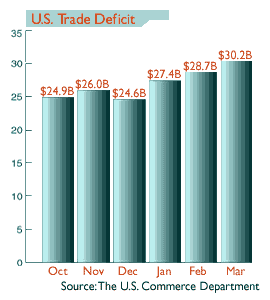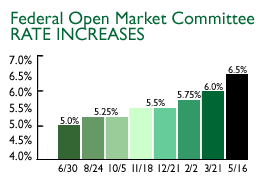|
Trade deficit hits record
|
 |
May 19, 2000: 1:34 p.m. ET
March trade gap widens to $30.2B, the highest deficit figure ever recorded
By Staff Writer M. Corey Goldman
|
NEW YORK (CNNfn) - The U.S. trade deficit widened to a record in March as demand for imported goods such as cars and aircraft parts continued at a hearty clip and the cost of oil held near decade highs -- even as exports jumped for a second month to a record, the government reported Friday.
 The trade deficit, which measures the amount of money spent on imports coming into the United States versus the amount taken in from exports leaving the country, widened in March to $30.2 billion, the Commerce Department said. That figure, which is the highest ever recorded for the deficit, was well above February's revised $28.7 billion deficit and above economists' estimates of a $29.7 billion deficit. February's figure was revised downward from the $29.2 billion first reported last month. The trade deficit, which measures the amount of money spent on imports coming into the United States versus the amount taken in from exports leaving the country, widened in March to $30.2 billion, the Commerce Department said. That figure, which is the highest ever recorded for the deficit, was well above February's revised $28.7 billion deficit and above economists' estimates of a $29.7 billion deficit. February's figure was revised downward from the $29.2 billion first reported last month.
The record trade imbalance provided yet another indication to analysts of the strength of the U.S. economy, currently in its record 110th month of uninterrupted expansion. That strength has been driven in large part by U.S. consumers' penchant to buy, something the Federal Reserve has been seeking to rein in by raising interest rates. Its latest move came Tuesday, when it raised its benchmark fed funds rate by half a percentage point.
"As far as the scorekeeping at the Fed is concerned, today's report will go down in the 'reasons to tighten further' column," said Jay Bryson, global economist with First Union National Bank.
Consumers on a binge
The data also came just days before a key vote in the U.S. House of Representatives on granting trade benefits to China. While the U.S. deficit with China shrank in March, the overall trade deficit was larger than expected and could harden the stance of some lawmakers who are against establishing permanent normal trade relations (PNTR) with Beijing.
 Officials in Washington, as well as Greenspan, hope to change that somewhat over the long term by swaying Congress to approve PNTR status, for China -- a move they say would promote economic development for both countries and encourage communist China to foster greater individual rights for its citizens. Officials in Washington, as well as Greenspan, hope to change that somewhat over the long term by swaying Congress to approve PNTR status, for China -- a move they say would promote economic development for both countries and encourage communist China to foster greater individual rights for its citizens.
That change could come sooner rather than later in the wake of the European Union's landmark trade pact with China, signed earlier Friday. The agreement ends four months of negotiations, which had threatened to cloud China's planned entry into the World Trade Organization (WTO).
"It is essential to approve normal trade relations with China; it will open the China market for us," Morici said. "It's an enormous market we need to capitalize on and it will improve our trade deficit over a long period," he said, adding that improving economic conditions in Asia and Europe will help offset the U.S. economy's strength going forward. (262KB WAV) (262KB AIFF)
The trade deficit with China slipped to $5.1 billion in March from $5.6 billion in February. It was $4.6 billion in February 1999.
Imports, exports hit records
Elsewhere, the deficit with Canada, the largest U.S. trading partner and destination for some 20 percent of all U.S. exports, rose to $3.9 billion from $3.1 billion. The deficit with Mexico fell to $1.9 billion from $2 billion. The deficit with Western Europe rose to $5.9 billion from $3.5 billion, while the deficit with Japan rose to $6.8 billion in March from $6.7 billion in February.
 Overall, imports into the U.S. rose to a record $117.4 billion in March, while exports rose to a record $87.26 billion, the Commerce Department said. Higher oil prices factored into the record deficit, with the average import price of crude oil ringing in at $26.38 a barrel in March, the highest since November 1990. Overall, imports into the U.S. rose to a record $117.4 billion in March, while exports rose to a record $87.26 billion, the Commerce Department said. Higher oil prices factored into the record deficit, with the average import price of crude oil ringing in at $26.38 a barrel in March, the highest since November 1990.
Crude oil prices have almost tripled in the past year, rising as high as $34 a barrel from a 12-year low of $10.35 reached in December 1998. The government also reported that the trade deficit with the Organization of Petroleum Exporting Countries, or OPEC, rose to a record $4.2 billion in March from $3.2 billion in February.
Overall imports of consumer goods rose 5.6 percent in March, while imports of cars and trucks gained 6.5 percent. Aircraft exports plunged 49.2 percent as Boeing Co. (BA: Research, Estimates), the world's biggest aircraft manufacturer, wrapped up a 38-day strike in the middle of the month before resuming production. Aircraft imports increased 63 percent.
The dollar factor
Financial markets took the numbers in stride, registering no surprise at the fact that the robust pace of the U.S. economy is pulling in a large amount of imported goods. "You couldn't say the number was completely unexpected," Morici said. "People aren't saving, which translates into buying products like cars and electronics, which translates into a trade deficit."
The reason the trade deficit is a threat to the economy is the striking imbalance between what American consumers and companies pull into the country and what they send back out to the rest of the world, something Fed officials, including Chairman Alan Greenspan, worry could create too much demand at home and too little supply from abroad.
 To be sure, analysts point to the strong U.S. dollar as one of the culprits that will likely keep the U.S. trade balance in deficit status for some time. That's because a strong U.S. currency makes American-made goods more expensive to overseas buyers, and makes goods and services imported from abroad cheaper for U.S. buyers. To be sure, analysts point to the strong U.S. dollar as one of the culprits that will likely keep the U.S. trade balance in deficit status for some time. That's because a strong U.S. currency makes American-made goods more expensive to overseas buyers, and makes goods and services imported from abroad cheaper for U.S. buyers.
As long as the Fed remains committed to raising rates, the U.S. dollar will continue to strengthen, "which will only push the gaping imbalance further into the red," noted Sherry Cooper, chief economist with brokerage BMO Nesbitt Burns Inc.
Steven Wood, an economist with Banc of America Securities in San Francisco, agreed. "Despite improving international economies, the strong dollar is limiting the expected rebound in exports," he said. Higher interest rates make the dollar and securities denominated in it more attractive.
And so far, most analysts are anticipating more rate increases from the Fed, judging by the implied yield on the fed funds futures contract trading on the Chicago Mercantile Exchange. The rate on the July contract, which suggests where investors think the fed funds rate will be in July, currently rests at 6.78 percent, more than a quarter point above its current 6.5-percent level. 
|
|
|
|
|
 |

|

